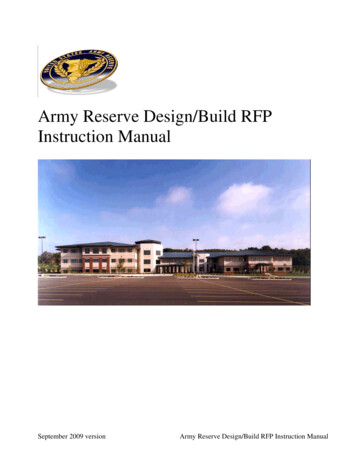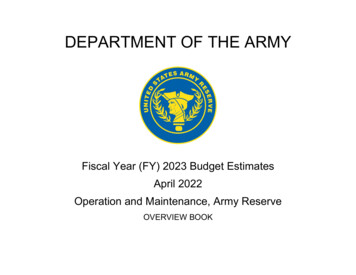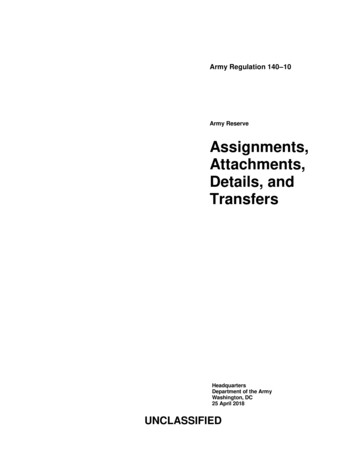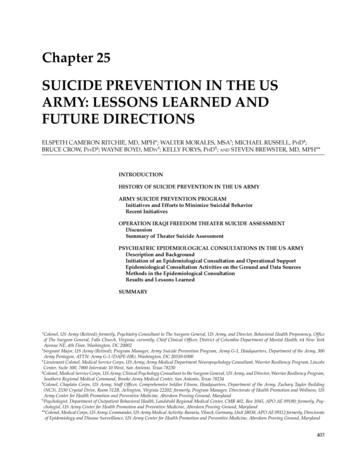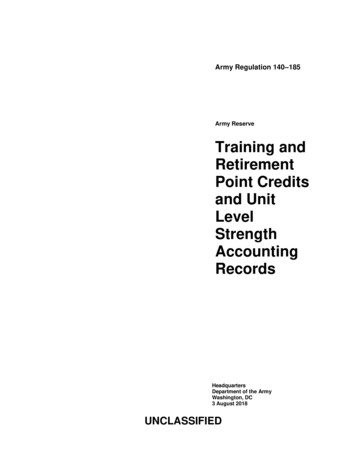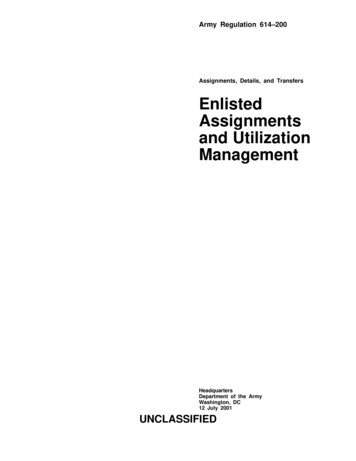
Transcription
Army Regulation 140–10Army ReserveAssignments,Attachments,Details, andTransfersHeadquartersDepartment of the ArmyWashington, DC15 August 2005UNCLASSIFIED
SUMMARY of CHANGEAR 140–10Assignments, Attachments, Details, and TransfersThis rapid action revision, dated 15 August 2005-oRemoves U.S. Army Reserve troop program unit soldiers when they complete theyears of service (para 7-2g(1)).oSuspends maximum years of service removals for troop program unit enlistedsoldiers upon declaration of partial or higher levels of mobilization (para7-2g(3)).oChanges all references to Office of the Chief of the Army Reserve to DeputyChief of Staff, G-1 to reflect the new alignment of responsibilities(throughout).oChanges all references to chief warrant officer (2-5) to the abbreviation CW#to conform to data standardization requirements (throughout).oChanges all references to PERSCOM and AR PERCEN to Human Resources Command,Alexandria (HRC-A) and Human Resources Command, St. Louis (HRC-STL)(throughout).oUpdates office symbols from DARP to AHRC and DAAR-ZA to DAPE-MP (throughout).Change 16. This change-oPermits an area commander to delegate reassignment, attachment, or detailauthority to a MUSARC commander (para 1-5b).oPermits an ARCOM or GOCOM commander to further delegate reassignment andattachment authority (para 1-5c).oAuthorizes the use of DA Form 4187 by USAREC officials to request assignmentorders (para 1-9d).oRequires a soldier to possess the required MOS for assignment to a TPU (para 26b).oPermits a commander to accept a soldier for assignment who is not MOSqualified for the duty position on enrollment in a formal course ofinstruction (para 2-6c).oExpands policy governing enlisted reassignments from the IRR to TPUs byUSAREC officials (para 2-6.1).oProhibits ROTC scholarship cadets from SMP participation (para 2-11b).
oTenures USARF school commandants and principal staff under tenure policyapplicable to unit commanders and principle staff (para 2-18f) and rescindsfaculty tenure (para 2-18.1).oRescinds enlisted assignments to USARF school faculty on attaining maximumyears of service (para 2-18.2).oRevises warrant officer candidate assignment policy (para 2-21.1).oRevises MSC and AMEDD assignment policy (chap 2, sec V).oImplements the Command Selection Program (chap 2, sec VII).oPermits area commanders to delegate branch transfer authority to an ARCOM orGOCOM commander (para 3-2).oWithdraws authority to change enlisted MOS (para 3-5).oRequires a soldier be released from an attachment for nonpayment of SGLIpremiums (para 3-11).oAuthorizes IRR involuntary reassignment of TPU officers who have notcompleted OBC, are overstrength, or are unsatisfactory participants (para 45.1).oProhibits IRR reassignment of TPU soldiers who have not completed IET (para 48b).oProvides for IRR involuntary reassignment of a TPU soldier who has not becomeDMOS qualified within 24 months (para 4-10l).oExplains that involuntary reassignment for unsatisfactory participation isdiscretionary in lieu of discharge proceedings (para 4-15a).oExpands and clarifies policy governing IRR involuntary reassignemnt forfailure to meet body fat standards (para 4-16);oAuthorizes IRR involuntary reassignment after review of a bar to reenlistment(para 4-17.1).oProhibits IRR reassignment to a TPU with an imposed bar to reenlistment (para4-17.1).oAuthorizes IRR involuntary reassignment because of overgrade (para 4-17.2);oProhibits IRR reassignment to a TPU or IMA position until OBC has beencompleted (para 4-28p).oRequires approval of TPU commander for assignment of a former unsatisfactoryparticipant (para 4-28q).oRemoves prescribed ARNG policy and procedures (para 5-5).oRemoves records disposition procedures prescribed by AR 600-8-104 (para 5-7).
oClarifies that the mandatory removal of a COL or promotable LTC is computedfrom the officer’s PED (para 7-2e);oRevises the years of service required for mandatory removal of TPU enlistedsoldiers (para 7-2g).oProvides for removal from an active status of soldiers with 20 or more years ofqualifying service for retired pay who fail to accrue 50 retirement pointsduring a retirement year (para 7-3.1).oSpecifies that AMEDD officers participating in the New STRAP must completeOBC within 36 months after completion of specialized training (para 7-5b).oClarifies the procedures for soldiers exempted from active duty duringmobilization (para 7-8f).oProvides an exception to removal for failure to accrue 50 retirement points ina retirement year (para 7-12a.1).oAuthorizes the retention of certain AMEDD officers until age 68 (para 714.1).oRequires approval of Chief of Chaplains to transfer USAR chaplains to otherReserve components (para 9-2a.1).oRevises the convening authority for selective retention boards (para 10-2).oRevises and clarifies the composition of selective retention boards (para 106b).oRevises the notification and memorandums used in the selective retentionprocess (figs 10-1 thru 10-6).oRescinds appendixes B through G.oIdentifies current area commands.oMakes administrative and technical corrections.
*Army Regulation 140–10HeadquartersDepartment of the ArmyWashington, DC15 August 2005Effective 15 September 2005Army ReserveAssignments, Attachments, Details, and Transfersgives procedures for interservice transferand selective retention of unit soldiers.Applicability. This regulation applies tothe Active Army, the Army NationalGuard, and the U.S. Army Reserve.History. This publication is a rapid actionrevision. The portions affected by thisrapid action revision are listed in thesummary of change.Summary. This regulation covers policyand procedures for assigning, attaching,removing, and transferring U.S. Army Reserve soldiers. It defines Ready ReserveControl Groups and the Selected Reserve.Detailed procedures are given for removing soldiers from an active status. It alsoProponent and exception authority.The proponent of this regulation is theDeputy Chief of Staff, G–1 (DCS, G–1).The proponent has the authority to approve exceptions or waivers to this regulation that are consistent with controllinglaw and regulations. The proponent maydelegate this approval authority, in writing, to a division chief with the proponentagency or its direct reporting unit or fieldoperating agency, in the grade of colonelor the civilian equivalent. Activities mayrequest a waiver to this regulation by providing justification that includes a fullanalysis of the expected benefits and mustinclude formal review by the activity’ssenior legal officer. All waiver requestswill be endorsed by the commander orsenior leader of the requesting activityand forwarded through higher headquarters to the policy proponent. Refer to AR25–30 for specific guidance.This regulation contains management control provisions in accordance with AR11–2, but it does not identify key management controls that must be evaluated.Supplementation. Supplementation ofthis regulation and establishment of command and local forms are prohibited without prior approval from HQDA, DCS,G–1, ATTN: DAPE–ZA, 300 Army Pentagon, Washington, DC 20310–0300.Suggested improvements. Users areinvited to send comments and suggestedimprovements on DA Form 2028 (Recommended Changes to Publications andBlank Forms) directly to HQDA, DCS,G–1, ATTN: DAPE–MP, 300 Army Pentagon, Washington, DC 20310–0300.Distribution. This publication is available in electronic media only and is intended for command levels B for ActiveArmy and A for the Army National Guardand U.S. Army Reserve.Army management control process.Contents(Listed by paragraph and page number)Chapter 1Introduction, page 1Purpose 1–1, page 1References 1–2, page 1Explanation of abbreviations and terms 1–3, page 1Policy 1–4, page 1Responsibilities 1–5, page 1Orders 1–6, page 2Appointment as cadets at U.S. military academies 1–7, page 2Request for orders 1–8, page 2Unit training restriction 1–9, page 3Reasonable commuting distance 1–10, page 3*This regulation supersedes AR 140–10, dated 1 September 1994.AR 140–10 15 August 2005UNCLASSIFIEDi
Contents—ContinuedChapter 2Ready Reserve Assignments, page 3Section IThe Ready Reserve, page 3Ready Reserve 2–1, page 3U.S. Army Reserve control groups 2–2, page 4Career management of U.S. Army Reserve officers and warrant officers 2–3, page 4Section IIThe Selected Reserve, page 4General 2–4, page 4Mandatory assignment 2–5, page 4Voluntary assignment 2–6, page 5Enlisted reassignments from the Individual Ready Reserve to a troop program unit by U.S. Army RecruitingCommand officials 2–6.1, page 5Voluntary and involuntary reassignment between troop program units 2–7, page 6USAR technician assignments 2–8, page 6Assignment of officers to TPU position vacancies 2–9, page 6Request for unit vacancy fill 2–10, page 6Simultaneous Membership Program 2–11, page 7Section IIIUnit Assignment Priorities, page 7Commissioned officer and warrant officer priorities 2–12, page 7Enlisted priorities 2–13, page 8Denied assignments 2–14, page 8Section IVUnit Assignment Policies, page 8Assignment limitations 2–15, page 8Branch qualification on assumption of command 2–15.1, page 9Officer personnel assignments 2–16, page 9Branch/functional area — commissioned officers only 2–17, page 9Command tenure 2–18, page 10USARF school staff and faculty tenure 2–18.1, page 10Enlisted assignment to a USARF school when attaining maximum years of service 2–18.2, page 11Voluntary reassignment from a TPU to an IRR control group 2–19, page 11Involuntary relief from drill sergeant duty 2–19.1, page 11Involuntary release of officers 2–20, page 11Enlisted personnel assignments 2–21, page 12Warrant officer candidate assignments 2–21.1, page 12Army aviator position assignments 2–22, page 13Chaplain position assignments 2–23, page 13Section VArmy Medical Department Assignments, page 13Scope 2–23.1, page 13Army Medical Department positions 2–24, page 13Medical Service Corps positions 2–25, page 14Section VIJudge Advocate Assignments, page 14Responsibility 2–26, page 14JAGC assignments 2–27, page 14Position filling by The Judge Advocate General 2–28, page 15iiAR 140–10 15 August 2005
Contents—ContinuedPositions in JAGC detachments and sections 2–29, page 15JAG assignment tenure 2–30, page 15Section VIICommand Selection Program, page 16Scope 2–31, page 16Responsibilities 2–32, page 16Appointment of an acting commander. 2–33, page 16Qualifications for command selection board consideration 2–34, page 16Command selection boards 2–35, page 17Selections 2–36, page 17Chapter 3Branch Transfer, Branch Detail, Change of Military Occupational Specialty, and Attachment, page 18Section ITransfer Between Branches, page 18Branch transfer 3–1, page 18Authority 3–2, page 18Procedures 3–3, page 18Malassigned staff specialists 3–4, page 19Section IIChange of Military Occupational Specialty and Detail to Other Branches, page 19Military occupational specialty changes 3–5, page 19Branch detail 3–6, page 19Section IIIAttachments, page 19General 3–7, page 19TPU attachments 3–8, page 20Training attachments 3–9, page 20Orders 3–10, page 20Release from attachment for nonpayment of Servicemens Group Life Insurance (SGLI) premiums 3–11, page 21Chapter 4The Individual Ready Reserve, page 21Section IIntroduction, page 21General 4–1, page 21Composition of the Individual Ready Reserve 4–2, page 21Section IITransfer and Reassignment of Officers and Warrant Officers To The IRR, page 21Scope 4–3, page 21Voluntary transfer or reassignment of troop program unit or individual mobilization augmentee officers or warrantofficers 4–4, page 21Involuntary reassignment of troop program unit or individual mobilization augmentee officers and warrant officers 4–5, page 22Involuntary reassignment of troop program unit officers who have not completed officer basic course, or are assignedabove the maximum allowable strength limits, or are declared unsatisfactory participants 4–5.1, page 22Routine assignments to the IRR 4–6, page 23Section IIITransfer and Reassignment of Enlisted Soldiers to the IRR, page 24AR 140–10 15 August 2005iii
Contents—ContinuedScope 4–7, page 24Policy governing the transfer or reassignment of troop program unit or individual mobilization augmentee enlistedsoldiers to the Individual Ready Reserve 4–8, page 24Voluntary reassignment of troop program unit or individual mobilization augmentee enlisted soldiers 4–9, page 24Involuntary reassignment of troop program unit or individual mobilization augmentee enlisted soldiers 4–10,page 25Routine assignment of enlisted soldiers to the Individual Ready Reserve 4–11, page 25Voluntary reassignment of a surviving son or daughter 4–12, page 26Voluntary reassignment for dependency or hardship 4–13, page 27Voluntary reassignment for pregnancy 4–14, page 28Involuntary reassignment for unsatisfactory participation 4–15, page 28Involuntary reassignment for failure to maintain Army body fat standards 4–16, page 28Involuntary reassignment for inability to perform prescribed duties due to parenthood 4–17, page 29Involuntary reassignment after a review of a bar to reenlistment 4–17.1, page 30Involuntary reassignment because of overgrade 4–17.2, page 30Involuntary reassignment for failing to report to a troop program unit or individual mobilization augmenteeassignment (NO–SHOW) 4–18, page 30Transfer from control group (Delayed Entry Program) 4–19, page 30Transfer from control group (ROTC) 4–20, page 31Section IVReassignments Within the IRR, page 31Scope 4–21, page 31Reassignment between IRR control groups 4–22, page 31Section VTraining IRR Soldiers, page 32Scope 4–23, page 32Training for mobilization 4–24, page 32Training for career progression 4–25, page 32Section VIRelease From IRR Assignment, page 32Scope 4–26, page 32Release from IRR control group assignment 4–27, page 32Limitations on reassignment to a troop program unit or individual mobilization augmentee position based on thereasons for assignment to the Individual Ready Reserve 4–28, page 33Limitations on reassignment to a troop program unit or individual mobilization augmentee position based on anIndividual Ready Reserve soldiers condition or status 4–29, page 33Chapter 5Transfer Between the U. S. Army Reserve and Army National Guard, page 38Section ITransfer from the U.S. Army Reserve, page 38Conditional release 5–1, page 38Enlistment or appointment in Army National Guard 5–2, page 38Section IITransfer from the Army National Guard, page 39Reserve of the Army status 5–3, page 39Conditional release 5–4, page 39Procedures 5–5, page 39Orders 5–6, page 39Disposition of records 5–7, page 39ivAR 140–10 15 August 2005
Contents—ContinuedChapter 6Transfer to and from the Retired Reserve, page 39Section ITransfer to the Retired Reserve, page 39Eligibility 6–1, page 39Orders and certificates 6–2, page 40Ordering Retired Reserve members to active duty 6–3, page 40Section IITransfer from the Retired Reserve, page 40Criteria for transfer 6–4, page 40Application for transfer 6–5, page 40Soldiers determined indispensable 6–6, page 41Transfer order 6–7, page 42Chapter 7Removal from Active Status, page 42Section IReasons for Removal, page 42General 7–1, page 42Length of service (removal rule 1) 7–2, page 42Maximum age (removal rule 2) 7–3, page 43Nonparticipation (removal rule 2.1) 7–3.1, page 43Nonselection for promotion (removal rules 3 and 4) 7–4, page 43Failure to complete military education requirements (removal rule 5) 7–5, page 44Nonacceptance of assignment (removal rule 6) 7–6, page 44Theological students failing to qualify for the Chaplain branch (removal rule 7) 7–7, page 44Miscellaneous reasons for removal (removal rules 8 through 16) 7–8, page 44Section IIExceptions to Removal from Active Status, page 45General 7–9, page 45Exception categories 7–10, page 45General exceptions 7–11, page 45Numbered exceptions 7–12, page 46Retention in an active status after failure to be selected for promotion (removal rules 3 and 4 and exception number2) 7–12.1, page 48Section IIIArmy Medical Department Officer Removal Exceptions and Processing Procedures, page 49General 7–13, page 49U.S. Army Reserve applicability 7–14, page 49Policy governing exceptions to removal for length of service or age 7–14.1, page 49Sequential extensions to removal rules 7–14.2, page 49Request procedures 7–14.3, page 50Reports 7–14.4, page 50Policy for TPU, IMA, and IRR soldiers 7–15, page 50Medical Corps (MC) officers of the TPU IMA, and IRR 7–16, page 50Policy for AMEDD officers on the Active Duty List (ADL) 7–17, page 50Chapter 8The Standby Reserve, page 50Scope 8–1, page 50Active Status List 8–2, page 51AR 140–10 15 August 2005v
Contents—ContinuedInactive Status List 8–3, page 51Screening of the Standby Reserve 8–4, page 51Chapter 9Interservice Transfer and Attachment, page 51Section ITransfer, page 51Interservice transfer 9–1, page 51Approval authority 9–2, page 52Applying for transfer 9–3, page 52Command processing 9–4, page 53Transmitting records 9–5, page 53Transfer from other Reserve components 9–6, page 53Section IIAttachment, page 54Authorized attachment 9–7, page 54Request for attachment 9–8, page 54Attachment from other Reserve components to U.S. Army Reserve units 9–9, page 54Chapter 10Selective Retention of Officers In Troop Program Unit, page 54General 10–1, page 54Convening authority 10–2, page 55Retention board responsibilities 10–3, page 55Zone of consideration 10–4, page 55Safeguard against premature removal 10–5, page 56Selection boards 10–6, page 56Communication with the board 10–7, page 56Disposition of nonselected officers 10–8, page 56Board errors and omissions 10–9, page 57Appendix A.References, page 62Table ListTable 1–1: Personnel Records disposition for appointment of cadets, page 3Table 4–1: Troop program unit and individual mobilization augmentee reassignment limitations based on the reasonfor assignment to the Individual Ready Reserve, page 34Table 4–2: The status or condition of an Individual Ready Reserve soldier which may limit reassignment to a troopprogram unit or individual mobilization augmentee duty position, page 35Figure ListFigure 4–1: Sample notification of recommended involuntary IRR reassignment for inability to perform prescribedduties due to parenthood, page 36Figure 4–2: Sample of soldier’s statement of acknowledgement regarding involuntary reassignment to the IRR forinability to perform prescribed duties due to parenthood–Continued, page 37Figure 4–2: Sample of soldier’s statement of acknowledgement regarding involuntary reassignment to the IRR forinability to perform prescribed duties due to parenthood, page 37Figure 10–1: Sample notification of consideration memorandum–Continued, page 57Figure 10–2: Sample selection notification memorandum, page 58Figure 10–2: Sample selection notification memorandum, page 58Figure 10–3: Sample of nonselection notification memorandum, page 59Figure 10–4: Format for board report, page 60Figure 10–5: Format for Enclosure 2 (List Number 1) to the board report, page 61viAR 140–10 15 August 2005
Contents—ContinuedFigure 10–6: Format of Enclosure 3 (List Number 2) to the board report, page 61GlossaryAR 140–10 15 August 2005vii
Chapter 1Introduction1–1. PurposeThis regulation prescribes policies, responsibilities, and procedures to assign, attach, detail, remove, or transfer U.S.Army Reserve (USAR) soldiers.1–2. ReferencesRequired and related publications and prescribed and referenced forms are listed in appendix A.1–3. Explanation of abbreviations and termsAbbreviations and special terms used in this regulation are explained in the glossary.1–4. Policya. Personnel management policies will provide for equality of treatment and opportunity for all Army reservists.Policy will be established without regard to race, religion, sex, or national origin.b. Marital status of a soldier or the employment, educational, or volunteer activities of the spouse will not beconsidered in the selection of a soldier for permanent change of station (PCS) or duty assignments. Exceptions arelisted in (1) through (3), below. Further exceptions must be approved by the Assistant Secretary of Defense (ForceManagement and Personnel).(1) To resolve compassionate situations according to current policies.(2) To keep Army couples together according to current policies.(3) When required by law (for example, to prevent conflict of interest between soldier’s duties and spouse’semployment).1–5. ResponsibilitiesOverall responsibilities are listed below. Specific responsibilities are given in each chapter. The provisions of thisparagraph are not applicable to soldiers serving on active duty (AD) in the USAR Active Guard Reserve (AGR)program (see AR 140–30).a. The following commanders may assign, attach, detail, or transfer soldiers under their jurisdiction unless restrictedto Headquarters, Department of the Army (HQDA) approval:(1) Commanding General (CG), U.S. Army Recruiting Command (USAREC).(2) CG, U.S. Army Human Resources Command–Alexandria (HRC–A). This responsibility extends to USARcommissioned officers who are currently serving on AD as Regular Army (RA) enlisted soldiers or warrant officers(WOs) (Dual Component soldiers).(3) Rescinded.(4) Area commanders.(5) Rescinded.b. Area commanders are authorized to—(1) Involuntarily reassign officers and WOs to the appropriate Individual Ready Reserve (IRR) control group, perparagraphs 2–3, 2–17c and d, and 2–20. This authority may not be delegated.(2) Reassign a troop program unit (TPU) officer, WO, or enlisted soldier to a TPU in another area command withconcurrence of the gaining area command, per paragraph 2–7.(3) Delegate reassignment, attachment, or detail authority to a subordinate Major U.S. Army Reserve Command(MUSARC).c. Where authority has been delegated, or otherwise provided by this regulation, MUSARC commanders mayreassign or attach soldiers under their command to—(1) Another MUSARC within the jurisdiction of the area command and with the approval of the gaining MUSARC.(1.1) Or between, commands subordinate to the MUSARC.(2) The appropriate IRR control group, per chapter 4.(3) The Retired Reserve, per chapter 6.(4) The Standby Reserve (Active or Inactive List), per chapter 8.d. A MUSARC commander may further delegate authority to reassign or attach soldiers to or between commandssubordinate to the U.S. Army Reserve Command (USARC) or U.S. Army Reserve General Officer Command(GOCOM). Where delegated—(1) A command authorized a commander in the grade of colonel may reassign or attach soldiers to or betweencommands subordinate to the colonel command.AR 140–10 15 August 20051
(2) A command authorized a commander in the grade of lieutenant colonel may reassign or attach soldiers to orbetween TPUs subordinate to the lieutenant colonel command.1–6. Ordersa. Assignment, reassignment, transfer, and attachment will be announced in written orders per AR 310–10. Theorder will include the paragraph and subparagraph, if applicable, of the regulation authorizing the action.b. Enlistments and reenlistments will not be announced in written orders.c. Orders assigning, attaching, detailing, removing, or transferring contractually or statutorily obligated commissioned officers who are Reserve Officers’ Training Corps (ROTC) scholarship recipients will include the phrase“Scholarship Recipient — recoupment applies.” This will be included as additional instructions per AR 310–10, ordersformat 450.1–7. Appointment as cadets at U.S. military academiesa. U.S. Army Reserve soldiers who are appointed to U.S. military academies will be—(1) Assigned to the proper holding detachment as shown in table 1–1.(2) Dropped from USAR strength accountability using loss transaction code MH.b. Unit commanders will send requests for reassignment and the Military Personnel Records Jacket, U.S. Army(MPRJ), to the proper orders issuing agency.c. The orders issuing agency will—(1) Issue reassignment orders.(2) Send reassignment orders and the MPRJ to the proper holding detachment as shown in table 1–1.(3) Send a copy of the reassignment order to Commander, HRC–STL, ATTN: AHRC–PR, 1 Reserve Way, St.Louis, MO 63132–5200.d. The CG, HRC–STL will—(1) Issue reassignment orders for IRR soldiers.(2) Send reassignment orders, the MPRJ, and Official Military Personnel File (OMPF) to the proper holdingdetachment as shown in table 1–1.(3) Upon receipt of unit reassignment orders from the orders issuing agency, attach the OMPF and send to theproper holding detachment as shown in table 1–1.1–8. Request for ordersa. DA Form 4651 (Request for Reserve Component Assignment or Attachment) will be used to request orders forthe personnel actions shown in (1) through (7), below. When used for requesting orders for contractually or statutorilyobligated commissioned officers who are ROTC scholarship recipients, the phrase “Scholarship Recipient — recoupment applies,” will be placed on DA Form 4651. The order issuing agency will then include the phrase as additionalinstructions, per AR 310–10, order format 450. The DA Form 4651 will be completed and forwarded to the properorders issuing agency. A copy is located at www.apd.army.mil. The soldier’s signature must appear on DA Form 4651in instances of voluntary assignment, transfer, or attachment.(1) Assignment or attachment to USAR TPUs of persons under the administrative jurisdiction of the commander,HRC–STL. Send requests to Commander, HRC–STL, 1 Reserve Way, St. Louis, MO 63132–5200. Enter the attentionlines shown below in item 1 of DA Form 4651.(a) ATTN: AHRC–OPM–O (for officers).(b) ATTN: AHRC–EPS–A (for enlisted personnel).(2) Transfer from USAR TPUs to HRC–STL.(3) Transfer between USAR TPUs.(4) Attachment between USAR TPUs.(5) Attachment to Reserve training units and individual mobilization augmentee (IMA) detachments.(6) Immediate reenlistment with concurrent reassignment, per AR 140–111.(7) Rescinded.b. Include the documents shown in (1) and (2), below when requesting assignment of USAR control group soldiersrecently released from AD.(1) Orders releasing the soldier from AD.(2) DD Form 214 (Certificate of Release or Discharge from Active Duty).c. Enlisted IRR and Standby Reserve soldiers are discharged on the date of expiration of term of service (ETS).Although the discharge is effective on ETS, orders are issued on the first day of the ETS month. To prevent a servicebreak, reassignment processing must begin when soldiers are within 6 months of ETS. Follow procedures in AR140–111.d. DA Form 4187 (Personnel Action) will be used by USAREC officials to request orders for the assignment ofenlisted soldiers from the IRR to a TPU. The USAREC guidance counselor will check the block marked “Has Been2AR 140–10 15 August 2005
Verified,” and sign and date DA Form 4187, section V, as the authorized representative. Under certain conditions (para2–6) recruiting personnel will be required to secure the signature of the TPU commander or designated representativebefore the request is sent to commander, HRC–STL. The DA Form 4187 with allied documents will be utilized bycommander, HRC–STL in conjunction with information on the Recruit Quota System (REQUEST) tape to prepareassignment orders.1–9. Unit training restrictionUnit commanders will not authorize soldiers transferred from the IRR to attend training assemblies or annual training(AT) without assignment orders. The effective date of assignment or attachment will be at least 10 days after the dateDA Form 4651 is submitted to the orders issuing authority. Retroactive dates of assignment or attachment to a unit arenot authorized.1–10. Reasonable commuting distancea. A reasonable commuting distance is defined as the longest distance a USAR soldier can be expected to travelinvoluntarily between his or her residence and a site where inactive duty training (IDT) will be conducted.(1) For officers, WOs, and enlisted soldiers, it is a distance within a 50–mile radius of the IDT site. It will notexceed 1 1/2 hours of travel time one–way by car under average traffic, weather, and road conditions.(2) There is an alternative reasonable commuting distance policy that can be applied when all of the conditions canbe met. The policy applies only to enlisted soldiers and provides for a reasonable commuting distance within a100–mile radius of the IDT site. It will not exceed 3 hours of travel time one–way by car under average traffic,weather, and road conditions. In addition, the following conditions must be met:(a) The soldiers must be assigned to units that normally conduct multiple unit training assemblies (MUTA) on 2consecutive days (MUTA–4).(b) Government–provided meals and quarters must be furnished at the training site.b. Roundtrip travel from home to perform IDT at the unit to which the soldier is assigned or attached will be at thesoldier’s expense. The USAR has no responsibility to provide transportation in these cases.Table 1–1Personnel Records disposition for appointment of cadetsHolding Detachment: Cadet Detachment, 1st Battalion 1st Inf (WIFBO1X) U.S. Military Academy West Point, NY 10096.Academy or Preparatory School: U.S. Military Academy West Point, NY.Holding Detachment: U.S. Military Academy Preparatory School (WIE501X), Fort Monmouth, NJ 07703.Academy or Preparatory School: U.S. Military Academy Preparatory School Fort Monmouth, NJ.Holding Detachment: USA Student Detachment (W30U1BX), ATTN: ATZI–SD–PSNCO, Fort Benjamin Harrison, IN 46216.Academy or Preparatory School: U.S. Coast Guard Academy New London, CT. Naval Academy Annapolis, MD. (Also applies to NavalAcademy Preparatory School, Naval Education and Training Center, Newport, RI 02841.) U.S. Air Force Academy, CO 80840
Enlisted reassignments from the Individual Ready Reserve to a troop program unit by U.S. Army Recruiting Command officials 2-6.1, page 5 Voluntary and involuntary reassignment between troop program units 2-7, page 6 USAR technician assignments 2-8, page 6 Assignment of officers to TPU position vacancies 2-9, page 6


